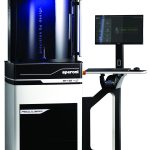Soft machine
Soft machine
Robust and stiff often come to mind when considering the characteristics that make for a productive milling machine. However, Juanjo Zulaika, a researcher at the applied-research center Tecnalia Research & Innovation, thought otherwise and developed a "softer" milling machine with reduced weight and stiffness. That's achieved while increasing productivity.
Robust and stiff often come to mind when considering the characteristics that make for a productive milling machine. However, Juanjo Zulaika, a researcher at the applied-research center Tecnalia Research & Innovation, thought otherwise and developed a "softer" milling machine with reduced weight and stiffness. That's achieved while increasing productivity. "Normally, the aim of these designs is to make the machine as stiff as possible," he said. "But that is not the case in my model, and this signifies a profound change in this area."


Courtesy of Tecnalia Research & Innovation
The low-energy consuming and reduced-weight 4m-high prototype milling machine from Nicolás Correa (top) was able to achieve greater DOCs than the initial machine (bottom).
Working with the Spanish University of the Basque Country, Zulaika created a simulation model that incorporates finite element analysis to analyze chatter and determine how much mass can be removed from a machine component without reducing productivity. "We calculate the eigenvectors and eigenfrequencies of the machine and, once we have the cutting coefficients of a machining operation, use those for calculating the machine's stability lobes for the machining process," he explained. (According to Merriam-Webster's dictionary, an eigenvector is a nonzero vector mapped by a given linear transformation of a vector space onto a vector that is the product of a scalar multiplied by the original vector. An eigenfrequency is one of the frequencies with which a given oscillatory system is capable of vibrating.)
Zulaika also uses the model to determine a machine's chatter frequencies. He then combines the information generated to improve the damping capability of the machine modes linked to chatter frequencies. "I remove mass and stiffness of those machine eigenfrequencies not related to any chatter frequency," he said. "It is as if a doctor were to diagnose the machine; I am told which components are too robust and which are too weak."
Zulaika then worked with machine tool builder Nicolás Correa S.A., Burgos, Spain, to apply the model and produce a 4m-high prototype milling machine that weighs about 20 percent less, with a proportional reduction in energy consumption, than the machine it was adapted from. In addition, productivity based on the achievable DOC when roughing increased, he noted. In comparison with the standard machine, productivity increased 100 percent in the best tests.
According to Zulaika, the static stiffness of the previous machine was too high—too robust—but its horizontal ram proved to be the weakest part because it was a long cantilever ram. However, he was able to even reduce the ram's weight by 30 percent from 3,900 kg to 2,700 kg while embedding a 30-kg active damping device from Micromega Dynamics S.A., Fernelmont, Belgium, in the ram. The device damps the machine modes excited during operation and is located in the slot where the ram is located. The prototype also incorporated passive damping devices, such as redundant guiding systems in the ram, to improve the damping coefficient of bending modes without increasing mass.
Although effective, Zulaika noted that end users are typically reluctant to have a machine with that active damping device. In addition to being leery of its approximate $35,000 price tag, more importantly, they doubt the device, with its cables and sensors, is robust enough to withstand the harsh machining environment. Research continues into alternative damping devices, such as a more robust and less expensive hydraulic one. "That is an aspect we are trying to improve prior to definitive commercialization of the prototype," he said.
For more information about Tecnalia Research & Innovation, Donostia-San Sebastián, Spain, call +34-902-760-000 or visit www.tecnalia.com.





